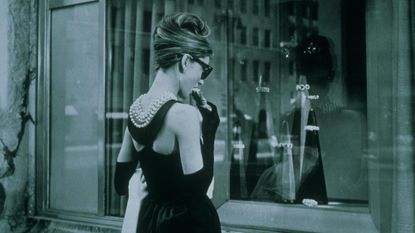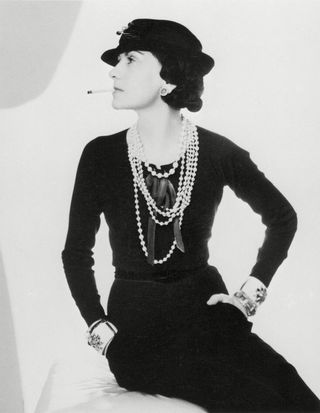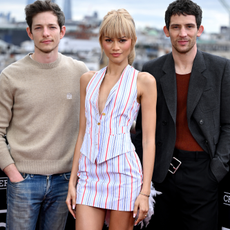A short yet comprehensive history of the little black dress
Including that iconic Audrey Hepburn Givenchy dress


Including that iconic Audrey Hepburn Givenchy dress
Hands up who thinks the little black dress was first created by Hubert de Givenchy for Audrey Hepburn in Breakfast at Tiffany’s? Well it turns out you’re in need of a fashion history lesson, because the LBD is a little older than that…
Of course, women have always worn black attire, especially in times like the Georgian and Victorian eras where you could be in mourning for up to four years after a death.
However, our contemporary version of cocktail dress first came into fashion in the 1920s, thanks to a certain Parisian designer named Coco Chanel.
Coco Chanel and the LBD
In 1926, Vogue published a drawing of a simple black dress in crêpe de Chine. It had long narrow sleeves and was accessorised with a string of pearls. The publication dubbed it ‘Chanel’s Ford’, in other words it was simple and accessible to women of all classes.
Vogue also said it would become ‘a sort of uniform for all women of taste’. Well, that was one spot-on prediction for sure.

Chanel later said, ‘I imposed black; it's still going strong today, for black wipes out everything else around.’
Marie Claire Newsletter
Celebrity news, beauty, fashion advice, and fascinating features, delivered straight to your inbox!
Her timing was of course, perfect. Because the dress was released in the Great Depression era, where simple and affordable was key. Later, during the war, textiles and fabrics were rationed, and the simple black dress remained the outfit of choice, as you could be elegant without breaking the bank.
Christian Dior's New Look
Another famous designer came along after the war and firmly cemented the little black dress in fashion history. I’m talking of course about Christian Dior, who truly changed women’s fashion with his New Look.
Full skirts and cinched waists gave the LBD a sexier update, and it wasn’t long before Hollywood stars adopted the style on and off screen.
And while I’m on the topic of movies, let’s go back to the previously mentioned Breakfast at Tiffany’s in 1961. There’s no arguing it’s one of the most famous dresses in cinematic history. Come on, is there a more iconic scene than the one of Audrey munching on a croissant and sipping coffee while admiring Tiffany’s jewellery, all the while wearing her Givenchy dress from the previous night’s party?
In fact, of the original dresses from the film was auctioned in 2006 for a hefty £467k. A suitably iconic price tag for such a notorious piece of costume.

Fun fact for you: originally, the dress was much shorter, but the film studios thought it showed too much of Audrey’s leg, so the lower half was redesigned by costume designer Edith Head.
Elizabeth Hurley, Princess Diana and the LBD
Since then, the party dress has been a firm favourite with the fashion world, changing styles with the decades. Sheath dresses were popular in the 60s, while shoulder suits and pouf dresses were big in the 80s, but it truly made a comeback in the 90s, the era of minimalist slip dresses (and Posh Spice).

You might think there’s something a little safe about LBDs, but I’d argue the opposite. If you take a look at the most talked about dress style in history, you’ll actually find it’s often the opposite.
Just look at that safety pin Versace that firmly put Elizabeth Hurley on the map, and the ‘revenge dress’ Princess Diana stepped out in after her divorce to Prince Charles.
The off-the-shoulder design by Greek designer Christina Stambolian, was deemed ‘too daring’ by certain critics, but I think it was just the right way for Diana to transition into a fashion icon.
Penny Goldstone is the Digital Fashion Editor at Marie Claire, covering everything from catwalk trends to royal fashion and the latest high street and Instagram must-haves.
Penny grew up in France and studied languages and law at the Sorbonne Nouvelle University in Paris before moving to the UK for her MA in multimedia journalism at Bournemouth University. She moved to the UK permanently and has never looked back (though she does go back regularly to stock up on cheese and wine).
Although she's always loved fashion - she used to create scrapbooks of her favourite trends and looks, including Sienna Miller and Kate Moss' boho phase - her first job was at MoneySavingExpert.com, sourcing the best deals for everything from restaurants to designer sales.
However she quit after two years to follow her true passion, fashion journalism, and after many years of internships and freelance stints at magazines including Red, Cosmopolitan, Stylist and Good Housekeeping, landed her dream job as the Digital Fashion Editor at Marie Claire UK.
Her favourite part of the job is discovering new brands and meeting designers, and travelling the world to attend events and fashion shows. Seeing her first Chanel runway IRL at Paris Fashion Week was a true pinch-me moment.
-
 Zendaya's reaction to awkward kissing question during Challengers interview has gone viral
Zendaya's reaction to awkward kissing question during Challengers interview has gone viral'Uncomfortable' doesn't begin to cover it
By Iris Goldsztajn
-
 Prince William feels 'immense responsibility' amid Kate and Charles cancer diagnoses
Prince William feels 'immense responsibility' amid Kate and Charles cancer diagnosesHe has a lot on his plate
By Iris Goldsztajn
-
 Taylor Swift just teased a 'timetable' for her new album release
Taylor Swift just teased a 'timetable' for her new album releaseThe wait is torture
By Iris Goldsztajn